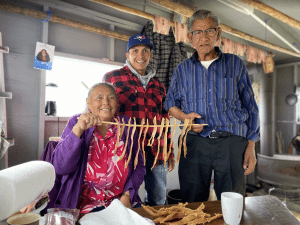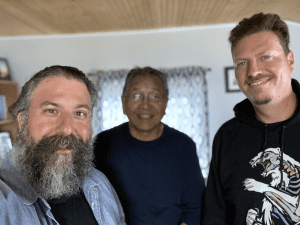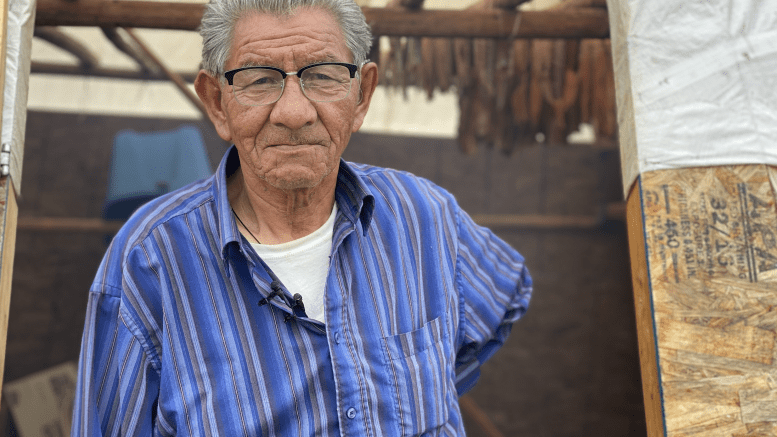The Tłı̨chǫ Government has funded a special project aimed at bringing new technology to ancient stories.
Paul Cressman, program development officer for the Tłı̨chǫ government says he was inspired by the pandemic and the lack of social gatherings permitted across the country.
“We can’t afford to wait, we need to get on this now,” says Cressman, “because of an acute awareness that Elders are passing away.”
“We started thinking how can we bring the land to the people,” he adds.

Elder Jonas Nitsiza with wife Lucy Nitsiza and son Frankie Nitsiza. (Photo courtesy of Jay Bulckaert)
The project, called see the trails of our ancestors, went from putting a Go-Pro camera on somebody’s head to recording the trails in high definition 360°, says Cressman.
This experience will be a series of interactive stories guided alongside traditional lands and river systems.
“It’s a revival of history,” says Chief Alfonz Nitsiza for Whatì.
The trails were the only means of transporting goods at the time, he adds.
As you move along the trails and find yourself at specific sites, video or audio prompts will share a significant story or detail about the site.
The team traveled from Whatì to Behchokǫ̀ on a 90-kilometer ancient trail system, recording all they saw and heard.
Cressman says in keeping the tradition alive by honoring the Tłı̨chǫ Annual gathering canoe trip.
The project will showcase the many significant landmarks and trails connecting all four communities in the Tłı̨chǫ region.
“Imagine Google Street View but for the Tłı̨chǫ Trails,” says Bulckaert.

Pablo Saravanja, left, Chief Alfonz Nitsiza and Jay Bulckaert.
(Photo courtesy of Jay Bulckaert)
Audiences will have the option to view the scenes by land, air, or water.
“They started with Whatì because they wanted to get visuals of the land before the all-season road was built and the landscape had changed,” says Cressman.
“I think it will be a really powerful tool to collect, gather, and protect traditional knowledge and culture,” he adds.
This project will not only benefit future generations “but give Elders a chance to travel their land virtually,” says Cressman.
Once completed the website will be available in Tłı̨chǫ Yatıì with English subtitles.
The project will take up to five years to complete with an allocated $200,000 budget provided the Tłı̨chǫ Governments department of Land and Culture.
The first installment should be available next spring.
Mariah Caruso is a digital journalist, originally from Toronto, Canada. She graduated from the University of Toronto with a Hons. Bachelor of Arts and completed her Journalism post-grad at Sheridan College. She has an insatiable appetite for life, storytelling, connecting to the people, and getting to the heart of the issue.
On her spare time, you can find her at your local coffee shop writing songs, poetry and prose or at the gym out-lifting men.
If you have a story idea, feel free to send her an email at mariah.caruso@cklbradio.com or call 867-766-2552 Ext 108






